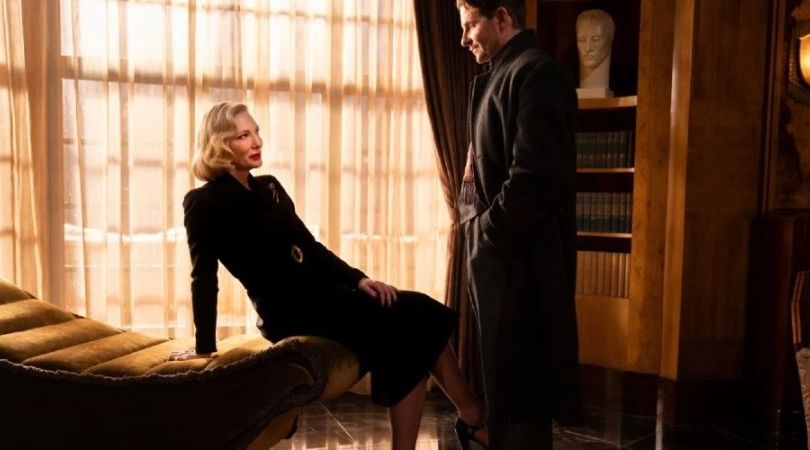
We know Guillermo del Toro for his ability to build empathy through his monsters and showcase the ability of humans to be the real evil. It’s almost a given at this point with del Toro films, the monster will become the hero, or the innocent lead will come to understand them. But for Nightmare Alley, del Toro creates a story so focused on the grime of humanity that empathy is left at the door…and it works. Directed by del Toro and featuring a screenplay from del Torro and Kim Morgan, and based on the novel of the same name by William Lindsay Gresham, Nightmare Alley packs a star-studded cast featuring: Bradley Cooper, Cate Blanchett, Toni Collette, Willem Dafoe, Richard Jenkins, Rooney Mara, Ron Perlman, Mary Steenburgen, and David Strathairn.
The premise is simple. A con man cons until his cons catch up to him. But despite the simplicity, Nightmare Alley builds on itself layers and layers of foreshadowing and detail that culminate in a sweet finale that captures a catharsis for all the characters we’ve seen along the way. At its center is Stanton Carlisle (Bradley Cooper), a charismatic man with the ability to con. Taken in by the carnies, Stanton endears himself to clairvoyant Zeena (Toni Collette) and her mentalist-turned drunk husband Pete (David Strathairn). Through observation and crafting a connection between himself and the pain, he crafts a golden ticket to success as a catapult out of the carnival and into the pockets of the richest of 1940s New York society. A man driven by his aspirations, the innocent and naive Molly (Rooney Mara) is along for the ride, taking every word as a sweet gospel promising her life just out of reach. One more show, one more con, then they can settle with the world at their feet. As Stanton plots to con a dangerous tycoon (Richard Jenkins) with the aid of a mysterious psychiatrist (Cate Blanchett), he begins to realize that he may not be as in control as he thinks.
Nightmare Alley is classic del Toro and yet sharply departed from the horrors we have come to expect. In one way, del Toro’s intention to make every element of the scene purposeful and meaningful takes center stage. From the start of the film to the end, there is one path that Stanton is barrelling towards. While it may not be surprising, it packs a punch propelled by Cooper’s award-worthy performance. To craft his narrative, del Toro uses ambition to fold each layer of development on top of each other. With more ambition comes more tension, and when the plot seems to have reached the point of becoming too thick, it’s cut open, allowing each element of the story to fall into place.
Del Toro painstakingly weaves together grime and glam to bring both squalor and decadence to life in a way only befitting of the time period. With showstopping set pieces and costuming that goes a mile past just fitting to the era, Nightmare Alley is a visual feast. The stark contrast of the dulled browns of the carnival against the vibrant jewel tones of a high society split the film into acts, with a third one better left untouched in this review. But the most shocking element of the film, given del Toro’s attention to creatures and monsters that you think would take center stage in a film set first at well, a freakshow, is how little we see of creature work. The monsters on display come in small jars tucked away behind curtains, and against that dressing, it’s the absolute rotten core of people on display.
With all of that said, it’s important to note that the beauty of the film stands on its own. The greatness of Nightmare Alley is achieved through the performances. With a smorgasbord of talented and charismatic actors in front of the camera, it’s shocking that none overpower the other. Each actor hits their mark in the ways that only they can. There are vulnerable performances, forceful ones, cold ones, unhinged ones, melancholic ones, and ones that shake with power and control that reaches through the screen.
No one is weak in this film, but even with that, Cooper and Blanchett chart a course all their own. Playing against each other, each character believes they are toying with the other like a mouse in a cat’s mouth, and the dance between the two is elegant and intimidating. For Cooper, this is the most transformative performance of his career, playing a man who changes his circumstance and personality multiple times through the course of the film. His charisma slowly chipped away throughout the 140 minutes runtime and yet bolstered at the same time. Cooper doesn’t just play Stanton as one man, but as many, becoming who needs to be as he rushes towards his goal.
Just a few notes away from perfection with lapses in pacing in the first act, Nightmare Alley is a film that turns in on itself, twisting under its own weight to reveal one of the most satisfying endings I’ve seen. Baked in noir and dripping in the dirtiest parts of humanity, it’s a del Toro film like you haven’t seen before.
Nightmare Alley is in theater nationwide on December 17, 2021.
Nightmare Alley
-
Rating - 9/109/10
TL;DR
Just a note away from perfection with small lapses in pacing, Nightmare Alley is a film that turns in on itself, twisting under its own weight to reveal one of the most satisfying endings I’ve seen this year.






